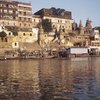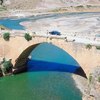The city of St. Louis was founded by French settlers in the 18th century and became part of the United States after the Louisiana Purchase in 1803. The settlement was located near the confluence of several rivers, which provided important links to other parts of the region. Today these rivers continue to play a vital role in the St. Louis area.
Mississippi River
Of all the rivers in the St. Louis area, the Mississippi River is the largest. It is also the one that passes through the city of St Louis for the greatest distance. The Mississippi forms the eastern border of the city, separating it from the city of East St. Louis in neighboring Illinois. The city contains Eads Bridge, the first road and rail bridge to cross the Mississippi River. Built in 1874, it remains a St. Louis landmark.
Missouri River
The Missouri River does not run through St. Louis itself, but flows into the Mississippi north of the city. The Missouri comes up from the southwest, then curves east to join the larger river. Although it does not technically pass through St. Louis city limits, the Missouri passes many surrounding communities and is an important part of the landscape of the St. Louis region. The Missouri River is approximately the northern border of St. Louis County.
River des Peres
The River des Peres, named after the French missionaries who established a mission in the St. Louis area, runs along the southwestern edge of the city. The river runs underground for much of its length and forms an important part of the city's sewage and storm drain facilities. The river has been extensively modified so that it now runs largely through artificial channels, having been diverted from its original course in order to function as part of the city's sewage system.
Meramec River
The Meramec River flows south of the city of St. Louis without entering the city itself. It runs through the Ozark highlands from Meramec Spring before draining into the Mississippi River. The Meramec is a popular river for canoeing and tour boats, as well as some commercial traffic. It was once heavily polluted, but cleanup attempts have made great progress and the river is now home to a diverse population of fish, waterfowl and other wildlife.
References
Photo Credits
- amolson7/iStock/Getty Images




